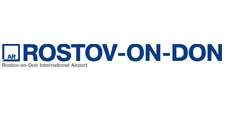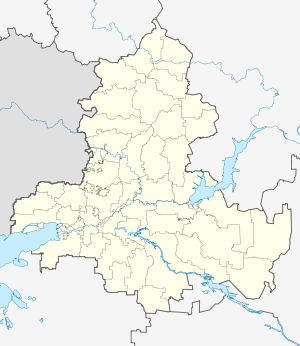Rostov-on-Don Airport
Rostov-on-Don Airport (Russian: Аэропорт Ростов-на-Дону) Aeroport Rostov-na-Donu (IATA: RVI (after Nov 26, 2017) / ROV (before Nov 27, 2017), ICAO: URRR) was an international airport located 8 km (5 mi) east of the city of Rostov-on-Don, in southern Russia. It was one of the largest airports in the south-west of Russia and the 12th busiest in the country.[4] It was founded in 1925 and was designated an international airport in 1986. The airport served 50 destinations in Russia and abroad and hosted 30 airlines.[4] It was a hub for Donavia.[4] In 2015, Rostov Airport handled 2.06 million passengers, including 565 thousand on international routes.[4]
Rostov-on-Don International Airport Международный аэропорт Ростов-на-Дону | |||||||||||
|---|---|---|---|---|---|---|---|---|---|---|---|
 | |||||||||||
 | |||||||||||
| Summary | |||||||||||
| Airport type | Public | ||||||||||
| Operator | JSC "Airport Rostov-on-Don" | ||||||||||
| Serves | Rostov-on-Don | ||||||||||
| Location | Rostov-on-Don, Russia | ||||||||||
| Elevation AMSL | 79 m / 259 ft | ||||||||||
| Coordinates | 47°15′30″N 039°49′6″E | ||||||||||
| Website | rnd-airport.ru | ||||||||||
| Map | |||||||||||
 RVI[3] Location of airport in Rostov Oblast | |||||||||||
| Runways | |||||||||||
| |||||||||||
| Statistics (2017) | |||||||||||
| |||||||||||
All regular and charter flights were transferred to Platov International Airport by 7 December 2017 11:00.[5] As of now airport is being closed for further demolition, by 1 March 2018 the old airport was scheduled to be officially closed.[6]
History
In 1925, an airfield was constructed near Rostov-on-Don.[7] A plot of 120 acres of land was allocated for it in the fields of one of Rostov-on-Don's suburbs.[7] A house for the airport's head and the staff, as well as fuel storage facilities, were constructed there.[7] A paved road connected the airport with the city.[7] On 15 June 1925 the first route (Rostov-Kharkov-Oryol-Moscow) was launched.[7] During the first three months, only 80 passengers were serviced, but in those days it was considered a success.[7] In 1926, Rostov became a stopover for a high-demand route from Moscow to Tiflis.[7] In the 1930s, the first terminal building was constructed.[7] During World War II the airport was destroyed.[7]
In the post-war years, Rostov airport had to be restored from the ruins. By 1949, a runway of 2,000 m, the terminal building, apron and taxiways were constructed and the airport was re-launched. The current airport terminal was constructed in 1977.[7] The same year, the airport's runway was strengthened and lengthened by 500m.[8] In 1986, Rostov was designated an international airport, and scheduled international flights were launched in 1991.[7] In 1992, the airport joined Airports Council International, the worldwide professional association of airport operators.[8]
In the 2000s, the airport was reconstructed, its runway was strengthened and lengthened from 2,500 m to 2,700 m and a new departure hall with 300 seats was constructed. In 2006–2007, modernization and expansion (for 200 more seats) of the international sector of the airport was carried out, including the installation of new passenger elevators and escalators as well as new luggage conveyor and equipment for customs control. In 2007, a renewed VIP hall was opened. In 2009, a new flight information system with 49 monitors was installed.[8] The airport's security was upgraded, including the installation of a new CCTV system and screening equipment at the terminal's entrances. In 2012, the airport's catering service was upgraded to provide up to 3000 flight meals a day.[8]
In 2007, passenger traffic exceeded 1 million people, and by 2013 this number had doubled. In 2014, Rostov Airport was taken over by Airports of Regions, the largest airport operator in Russia.[4]
The new Platov International Airport have been constructed for the upcoming 2018 FIFA World Cup. All flights from the current airport were transferred to the new facility on 7 December 2017.[9]
Infrastructure
The airport meets International Civil Aviation Organization 4D standards. It has one concrete runway, 04/22, PCN 59/R/C/W/T, 2,500 m (8,200 ft) long and 45 m (148 ft) wide.[10] The minimum visibility for take-off is 200 m.[10]
The airport is certified to handle aircraft up to the size of the Airbus A321 and Boeing 767, as well as any types of helicopters.[10] It has an apron with 53 parking positions and total area of 449,780 sq.m.
A terminal building, constructed in 1977, provides an operational area of 15,537 sq.m.[8] It can serve 600 passengers per hour on domestic routes, and 450 passengers per hour on international routes.[8]
Airlines and destinations
There are no longer regular flights at the airport. The last regular flight was made on 7 December 2017 by Aeroflot to Saint Petersburg. The airport was scheduled to be fully closed on 1 March 2018, but during 2018 FIFA World Cup it will work as a spare runway and/or during emergency situations.
Statistics
Annual traffic
| Year | Passengers | % Change |
|---|---|---|
| 2010 | 1,440,000 | |
| 2011 | 1,716,680 | |
| 2012 | 1,873,644 | |
| 2013 | 2,167,728 | |
| 2014 | 2,342,302 | |
| 2015 | 2,062,855 | |
| 2016 | 2,094,953 | |
| 2017 | 2,766,000 | |
Incidents and accidents
.jpg)
On 19 March 2016, at 3:42 AM local time, Flydubai Flight 981, a Boeing 737-800 on a passenger flight from Dubai, while executing a go-around, crashed at a high angle and speed by the end of Runway 22. All 62 people aboard died in the crash. The crash damaged 350 sq.meters of the airport's only runway and destroyed ten runway lights.[12] The airport was closed down for several days for the air crash investigation's field survey and the runway repair. The circumstances and reasons of the crash are still to be determined by the Russian Interstate Aviation Committee, with the participation of the airline's specialists and foreign experts, who continue the investigative actions into the airport.[13][14]
References
- "Аэропорту Ростова присвоили новый код" (in Russian). RostovGazeta. 27 November 2017. Retrieved 27 November 2017.
- "Аэропорту Ростова присвоили новый код" (in Russian). RostovGazeta. 27 November 2017. Retrieved 27 November 2017.
- "Аэропорту Ростова присвоили новый код" (in Russian). RostovGazeta. 27 November 2017. Retrieved 27 November 2017.
- "Аэропорт сегодня" [Airport today] (in Russian). Official website of Rostov-on-Don Airport. Retrieved 24 March 2016.
- "Все внутрироссийские и международные рейсы переводятся в аэропорт Платов с 7 декабря 2017 года – Аэропорт Платов". platov.aero (in Russian). Международный аэропорт "Платов". Retrieved 28 November 2017.
- http://www.ato.ru/content/aeroport-platov-razreshili-vvesti-v-ekspluataciyu-s-noyabrya?slink=frs&pos=1
- "История аэропорта Ростов-на-Дону" [History of Rostov-on-Don Airport] (in Russian). Official website of Rostov-on-Don Airport. Retrieved 24 March 2016.
- "20 лет ОАО "Аэропорт Ростов-на-Дону"" [20 years of JSC "Rostov-on-Don Airport"] (pdf) (in Russian). Rostov-on-Don Airport. 2013. Retrieved 25 March 2016.
- "Все внутрироссийские и международные рейсы переводятся в аэропорт Платов с 7 декабря 2017 года – Аэропорт Платов". platov.aero (in Russian). Международный аэропорт "Платов". Retrieved 28 November 2017.
- "Характеристики аэродрома" [Airport Characteristics] (in Russian). Official website of Rostov-on-Don Airport. Retrieved 24 March 2016.
- Пассажиропоток аэропортов УК. "Аэропорты Регионов" в 2017". www.aex.ru.
- "В аэропорту Ростов-на-Дону начато восстановление взлетно-посадочной полосы" [The restoration of the runway started at the Rostov-on-Don airport] (in Russian). Official website of Rostov-on-Don Airport. 20 March 2016. Retrieved 24 March 2016.
- "Boeing 737-800 А6-FDN 19.03.2016". Interstate Aviation Committee. 19 March 2016. Retrieved 19 March 2016.
- "ASN Aircraft accident Boeing 737-8KN A6-FDN Rostov Airport (ROV)". Aviation Safety Network. Retrieved 19 March 2016.
External links
![]()
- Rostov-on-Don Airport official website
- Accident history for ROV at Aviation Safety Network
- Airport information for URRR at Great Circle Mapper.
- Current weather for URRR at NOAA/NWS
- Airport information for URRR at World Aero Data. Data current as of October 2006.